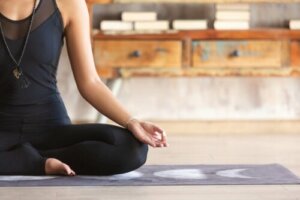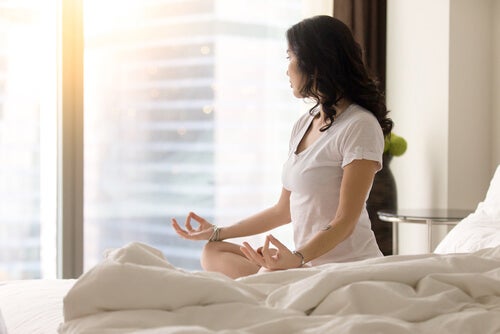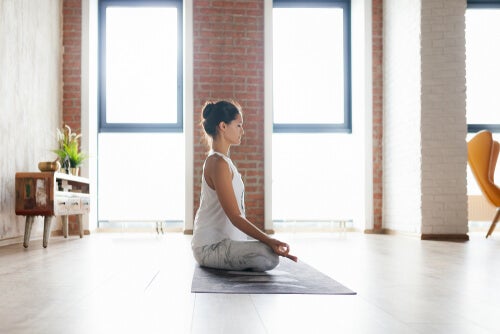Three Meditation Exercises to Practice at Home

These meditation exercises derive from an ancient technique used for training your mind to reduce stress, anxiety, and, also, to connect deeper with yourself. In fact, just 30 minutes a day can considerably change these states of mind. Furthermore, not only does it lessen any discomfort you might have but it also helps you feel much better.
Although you may not know it, there are many advantages to meditating at home. However, you must find a place away from distractions to do so. It’ll help you feel much better and more protected. The best part is you can do it at any time of the day.
It can be a bit difficult to attain an optimal state of concentration and relaxation if you’ve never meditated before. However, just follow a few simple steps and practice it frequently, and you’ll see how soon you get it.

Firstly, create an appropriate atmosphere where to practice meditation exercises
Before preparing your meditation environment, you must decide whether you’ll do these exercises on your own accord or if you’ll follow the guidelines of an app or a video.
Apps are very useful. In fact, you can program the time you want to dedicate and the level from which you’d like to start. Also, they make this practice easier for beginners.
Once you’ve decided how to do it, you’ll have to take into account the following to make the most out of it:
- Find a quiet place. It’s essential to find a corner that’s as silent as possible, where the possibility of interruption is either null or minimal. You won’t get good results in a spot where there are frequent interruptions.
- Comfortable posture. The lotus position is the classic choice for meditation, but you can start with other postures. You can even meditate while lying down. The most important thing here is to be in a relaxed position in which your body isn’t a distraction.
- Avoid distractions. As we indicated above, it’s essential to avoid all sources of distractions: turn off your phone, the television, close the door of the room, close the windows, etc. You must be relaxed enough to be able to focus on your bodily sensations.
- Finally, find the right moment. Yes, meditation is good for reaching a state of relaxation. However, if you do it in a hurry or under pressure, you won’t be able to do it correctly and the practice will be pointless. As you can see, you must choose a time in which you feel well enough and you can put your mind into it.
Basic meditation exercises to practice at home
Although there are many techniques for meditation exercises, some of them are easier for beginners to meditate at home.
1. Breathing exercises
This is the most basic exercise for relaxation and meditation. All you have to do is concentrate on your breathing. Controlling this physiological mechanism is essential for you to be able to relax. Note that it requires practice and concentration in spite of how easy it seems to be.
Forgetting about external stimuli, begin to take deep and slow breaths. Pay attention to them and notice how your body relaxes. Try to ignore any thoughts you might have at the moment and give your body your full attention.
In addition to being very useful in itself, you’ll also use it during the other two. Thus, it’ll be your basis for meditation.
2. Objective observation
In the previous exercise, you were encouraged to avoid thoughts. Contrary to it, the goal of this exercise consists of relaxing your body and allowing your thoughts to flow.
Thus, it’ll be necessary to focus on “watching” your thoughts without trying to change them or intervene in any way. Simply pay attention to them and let them be.
Ultimately, this exercise is about being a witness to your thoughts without getting carried away by them. It’s about thinking about them without judgment and watching them go by without concentrating on any of them in particular.
3. Body scan
Another simple exercise to meditate at home is the body scan technique. For this exercise, you must be in a comfortable position while controlling your breathing. Also, you must focus on the various areas of your body and the sensations you’re experiencing at that particular moment.
To do this, you first have to try to clear your mind and leave it blank while you focus on your various muscle groups.
For example, start by connecting with your feet; feel them, without judging them, and notice the sensations you have in them. Then, move on to your legs and notice the weight, the heat, the shape, and so on until you go through your entire body.

Progress after practicing meditation exercises
As with every form of exercise, you must be constant and patient. You probably won’t notice much difference and will be a little disappointed at the beginning. This is normal.
However, it’s hard to get short-term benefits with this practice. To do it, you must give yourself time and continue to try it even though it doesn’t go as you thought it would.
Some people think you have to do something for about 21 days in order for it to become a habit. However, you must go beyond and try to build a new lifestyle. In other words, integrate this new activity into your routine and try to find the right time and environment for it. Especially when it comes to working on your emotions. Progression is slow when it comes to meditation but the benefits are well worth it.
These meditation exercises derive from an ancient technique used for training your mind to reduce stress, anxiety, and, also, to connect deeper with yourself. In fact, just 30 minutes a day can considerably change these states of mind. Furthermore, not only does it lessen any discomfort you might have but it also helps you feel much better.
Although you may not know it, there are many advantages to meditating at home. However, you must find a place away from distractions to do so. It’ll help you feel much better and more protected. The best part is you can do it at any time of the day.
It can be a bit difficult to attain an optimal state of concentration and relaxation if you’ve never meditated before. However, just follow a few simple steps and practice it frequently, and you’ll see how soon you get it.

Firstly, create an appropriate atmosphere where to practice meditation exercises
Before preparing your meditation environment, you must decide whether you’ll do these exercises on your own accord or if you’ll follow the guidelines of an app or a video.
Apps are very useful. In fact, you can program the time you want to dedicate and the level from which you’d like to start. Also, they make this practice easier for beginners.
Once you’ve decided how to do it, you’ll have to take into account the following to make the most out of it:
- Find a quiet place. It’s essential to find a corner that’s as silent as possible, where the possibility of interruption is either null or minimal. You won’t get good results in a spot where there are frequent interruptions.
- Comfortable posture. The lotus position is the classic choice for meditation, but you can start with other postures. You can even meditate while lying down. The most important thing here is to be in a relaxed position in which your body isn’t a distraction.
- Avoid distractions. As we indicated above, it’s essential to avoid all sources of distractions: turn off your phone, the television, close the door of the room, close the windows, etc. You must be relaxed enough to be able to focus on your bodily sensations.
- Finally, find the right moment. Yes, meditation is good for reaching a state of relaxation. However, if you do it in a hurry or under pressure, you won’t be able to do it correctly and the practice will be pointless. As you can see, you must choose a time in which you feel well enough and you can put your mind into it.
Basic meditation exercises to practice at home
Although there are many techniques for meditation exercises, some of them are easier for beginners to meditate at home.
1. Breathing exercises
This is the most basic exercise for relaxation and meditation. All you have to do is concentrate on your breathing. Controlling this physiological mechanism is essential for you to be able to relax. Note that it requires practice and concentration in spite of how easy it seems to be.
Forgetting about external stimuli, begin to take deep and slow breaths. Pay attention to them and notice how your body relaxes. Try to ignore any thoughts you might have at the moment and give your body your full attention.
In addition to being very useful in itself, you’ll also use it during the other two. Thus, it’ll be your basis for meditation.
2. Objective observation
In the previous exercise, you were encouraged to avoid thoughts. Contrary to it, the goal of this exercise consists of relaxing your body and allowing your thoughts to flow.
Thus, it’ll be necessary to focus on “watching” your thoughts without trying to change them or intervene in any way. Simply pay attention to them and let them be.
Ultimately, this exercise is about being a witness to your thoughts without getting carried away by them. It’s about thinking about them without judgment and watching them go by without concentrating on any of them in particular.
3. Body scan
Another simple exercise to meditate at home is the body scan technique. For this exercise, you must be in a comfortable position while controlling your breathing. Also, you must focus on the various areas of your body and the sensations you’re experiencing at that particular moment.
To do this, you first have to try to clear your mind and leave it blank while you focus on your various muscle groups.
For example, start by connecting with your feet; feel them, without judging them, and notice the sensations you have in them. Then, move on to your legs and notice the weight, the heat, the shape, and so on until you go through your entire body.

Progress after practicing meditation exercises
As with every form of exercise, you must be constant and patient. You probably won’t notice much difference and will be a little disappointed at the beginning. This is normal.
However, it’s hard to get short-term benefits with this practice. To do it, you must give yourself time and continue to try it even though it doesn’t go as you thought it would.
Some people think you have to do something for about 21 days in order for it to become a habit. However, you must go beyond and try to build a new lifestyle. In other words, integrate this new activity into your routine and try to find the right time and environment for it. Especially when it comes to working on your emotions. Progression is slow when it comes to meditation but the benefits are well worth it.
This text is provided for informational purposes only and does not replace consultation with a professional. If in doubt, consult your specialist.







